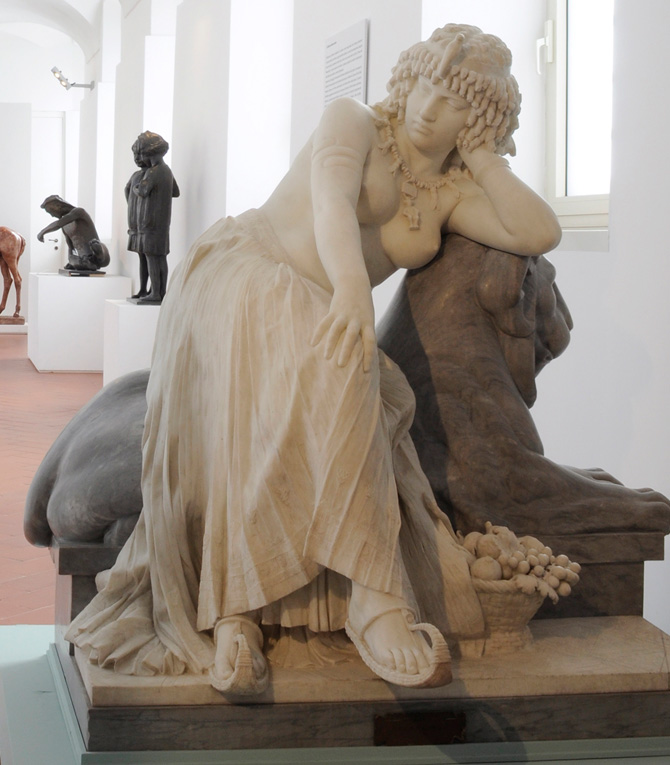Villanovan Crested Helmet 8th C. BCE
"This example is outstanding both for its excellent state of preservation and for the elaborate, accurate decoration visible on the skull, as well as on the surface of the crest. Exclusively composed of geometric patterns, it consists of several friezes of raised knobs, alternating with rows of small beads and triangular hatching. The upper crest was modeled in iron, as attested by the abundant remains of this metal: it is no longer possible to determine whether this was planned from the beginning, or whether it is an antique repair.
The slight, regular deformation on the skullcap, which would have resulted from a sword stroke (the blade left a very visible trace on the bronze, but did not cut it), confirms that these helmets were intended to be used on the battlefield, although most of them were finally dedicated in sanctuaries or carried into the tomb by their last owner.
First adopted in the eastern Mediterranean regions, metal helmets progressively reached the European continent as of the mid-2nd millennium BC and spread throughout the Aegean world, in Italy and then north of the Alps. Their development was parallel to that of other elements of the defensive panoply, like the shield, the greaves and the armor, which were also worked in sheets or plaques of bronze.
From the beginning, the main function of such a helmet was to protect the head of its owner from hostile blows; the different types of antique helmets therefore inform us about the weapons in use and the modes of battle. But the panoply (helmet and shield especially, because more visible on the battlefield) had a second purpose, which was to let allies and opponents know the status of its owner (soldier, leader) and to intimidate enemies by appearing stronger, better armed and more powerful, particularly with the crest. This is most obvious for this helmet, whose remarkable crest is entirely made of bronze. From a practical point of view, such a crest also served to strengthen the central part of the helmet, which was its most vulnerable area.
According to the archaeological data, such helmets were typically Etruscan, and more precisely Italic: the finest specimens were excavated in the necropolises of Tarquinia, Vulci and Veius (southern Etruria), and can be technically and artistically linked to our helmet.
They would have been high-priced items, since the only examples that were found outside the Italic world come from Delphi and Olympia, the seats of the two largest Panhellenic sanctuaries. Although it cannot be historically attested, one can imagine that these helmets were offered to Apollo and Zeus, as trophies by soldiers of Greek origin after a battle in Italy or by philo-Hellenic Etruscans."
-taken from archaicwonder.tumblr link below
Source/Quote:
https://archaicwonder.tumblr.com/post/131448944883/villanovan-crested-helmet-1st-half-of-the-8th
The slight, regular deformation on the skullcap, which would have resulted from a sword stroke (the blade left a very visible trace on the bronze, but did not cut it), confirms that these helmets were intended to be used on the battlefield, although most of them were finally dedicated in sanctuaries or carried into the tomb by their last owner.
First adopted in the eastern Mediterranean regions, metal helmets progressively reached the European continent as of the mid-2nd millennium BC and spread throughout the Aegean world, in Italy and then north of the Alps. Their development was parallel to that of other elements of the defensive panoply, like the shield, the greaves and the armor, which were also worked in sheets or plaques of bronze.
From the beginning, the main function of such a helmet was to protect the head of its owner from hostile blows; the different types of antique helmets therefore inform us about the weapons in use and the modes of battle. But the panoply (helmet and shield especially, because more visible on the battlefield) had a second purpose, which was to let allies and opponents know the status of its owner (soldier, leader) and to intimidate enemies by appearing stronger, better armed and more powerful, particularly with the crest. This is most obvious for this helmet, whose remarkable crest is entirely made of bronze. From a practical point of view, such a crest also served to strengthen the central part of the helmet, which was its most vulnerable area.
According to the archaeological data, such helmets were typically Etruscan, and more precisely Italic: the finest specimens were excavated in the necropolises of Tarquinia, Vulci and Veius (southern Etruria), and can be technically and artistically linked to our helmet.
They would have been high-priced items, since the only examples that were found outside the Italic world come from Delphi and Olympia, the seats of the two largest Panhellenic sanctuaries. Although it cannot be historically attested, one can imagine that these helmets were offered to Apollo and Zeus, as trophies by soldiers of Greek origin after a battle in Italy or by philo-Hellenic Etruscans."
-taken from archaicwonder.tumblr link below
 |
| Villanovan Crested Helmet 8th C. BCE. |
 |
| Detail. |
Source/Quote:
https://archaicwonder.tumblr.com/post/131448944883/villanovan-crested-helmet-1st-half-of-the-8th


Comments
Post a Comment